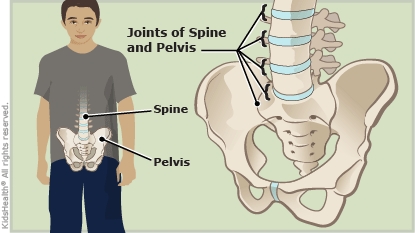Juvenile ankylosing spondylitis (JAS) is a type of arthritis. It affects the spine (backbone), the pelvis, and large joints of the leg (like the hips). Starting treatment as early as possible can help relieve pain and make other problems less likely. Although there is no cure for juvenile ankylosing spondylitis, most people who have it can live active, healthy lives.



Your child:

Your child:

What do the words "juvenile ankylosing spondylitis" mean? The words refer to inflammation (redness, heat, pain, or swelling) of the joints in the spine, resulting in a stiff or painful back:
What happens in juvenile ankylosing spondylitis? When a child has juvenile ankylosing spondylitis, the joints in the spine, pelvis, or legs become inflamed (irritated). Over time, this inflammation can damage the bones in the joints. The damaged bones can cause pain in the lower back or large joints of the leg. Also, the bones that make up the spine (vertebrae) may eventually fuse together, causing stiffness in the back.
Some kids with juvenile ankylosing spondylitis have other problems, including:
Symptoms might come and go. Some kids might have only mild symptoms, while others might be more severely affected. It is different for every child.
Who gets juvenile ankylosing spondylitis? It is seen more often in boys and tends to run in families. Symptoms usually begin in the late teens or young adulthood.
How is juvenile ankylosing spondylitis treated? The goal of treatment is to help your child have as normal and active a lifestyle as possible. The main treatments for juvenile ankylosing spondylitis are medicines, exercises, and physical therapy to help decrease pain and increase flexibility. If someone has severe pain or joint damage, surgery is sometimes recommended.